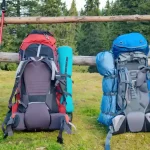

Eco-Friendly Camping: How to Leave No Trace and Protect the Outdoors
by
Sarah Patel
As a travel writer and outdoor enthusiast, I have had the privilege of exploring some of the most beautiful camping destinations around the world. However, with this privilege comes great responsibility. It’s our duty to ensure that we leave no trace and protect the outdoors for future generations to enjoy. In this blog post, I’ll share some essential tips and practices for eco-friendly camping, so that we can all do our part in preserving the natural beauty of our planet.
What is Eco-Friendly Camping?
Eco-friendly camping, also known as Leave No Trace camping, is a set of principles that promote responsible camping practices aimed at minimizing our impact on the environment. It’s about leaving nature as we found it, so that future generations can experience the same pristine wilderness that we have had the opportunity to enjoy. The Leave No Trace Center for Outdoor Ethics has developed seven principles that serve as guidelines for eco-friendly camping:
- Plan Ahead and Prepare: Proper planning is the first step in leaving no trace. Research the regulations and rules of the camping area, check weather conditions, and pack accordingly. Make sure to bring reusable camping gear and supplies to reduce waste.
- Travel and Camp on Durable Surfaces: Stick to established trails and campsites to avoid trampling on delicate vegetation. Camp at least 200 feet away from lakes and streams to protect water sources.
- Dispose of Waste Properly: Pack out all trash, leftover food, and litter. Use established bathroom facilities when available, or dig a small hole at least 200 feet away from water sources to bury human waste.
- Leave What You Find: Don’t disturb natural or cultural features, and leave rocks, plants, and artifacts where you find them. Avoid building structures or digging trenches at campsites.
- Minimize Campfire Impact: Use a camp stove for cooking instead of making a campfire, or use established fire rings or fire pans if fires are allowed. Burn only small sticks and twigs that can be broken by hand, and put out fires completely before leaving.
- Respect Wildlife: Observe wildlife from a distance and do not approach or feed them. Store food and trash securely to avoid attracting wildlife to your campsite.
- Be Considerate of Other Visitors: Keep noise levels down, yield to other hikers on the trail, and respect the privacy and tranquility of other campers.
Practical Tips for Eco-Friendly Camping
Now that we know the Leave No Trace principles, let’s dive into some practical tips for eco-friendly camping that we can apply during our camping adventures:
Choose Sustainable Camping Gear
Opt for camping gear that is made from eco-friendly materials, such as recycled or organic materials. Look for camping tents, sleeping bags, and camping furniture that are certified by organizations like Fair Trade Certified, Bluesign, or Green Seal. Avoid single-use camping items and opt for reusable camping gear, such as a reusable water bottle, camping cookware, and food storage containers. Also, invest in durable camping gear that can last for many camping trips, reducing the need for frequent replacements.
Minimize Waste
Pack out all trash, leftover food, and litter, and properly dispose of them in designated trash receptacles or recycling stations. Avoid bringing unnecessary packaging and single-use items, and instead, opt for bulk or unpackaged food items. Use a reusable cloth bag for grocery shopping and avoid plastic shopping bags. Compost food scraps and organic waste, or pack them out in a separate bag to minimize the impact on the environment.
Conserve Water
Water is a precious resource, especially in camping areas where water sources may be limited. Conserve water by using biodegradable soap for washing dishes and yourself, and use a water filter or purification tablets to treat water from natural sources such as streams or lakes. Avoid letting water run unnecessarily and report any leaks or water waste to the campground authorities.
Practice Leave No Trace Principles
As mentioned earlier, following the Leave No Trace principles is crucial in eco-friendly camping. Stick to established trails, campsites, and fire rings, and avoid disturbing natural or cultural features. Pack out all trash, leftover food, and litter, and bury human waste at least 200 feet away from water sources. Respect wildlife by observing them from a distance and avoiding feeding them. Be considerate of other campers by keeping noise levels down and yielding to other hikers on the trail.
Use Eco-Friendly Campfire Practices
Campfires can have a significant impact on the environment if not managed properly. To minimize campfire impact, use a camp stove for cooking instead of making a campfire, or use established fire rings or fire pans if fires are allowed. Burn only small sticks and twigs that can be broken by hand, and put out fires completely before leaving. Avoid burning trash, plastic, or other non-organic materials, as they can release harmful pollutants into the air.
Support Local Conservation Efforts
Many camping areas are managed by local conservation organizations or government agencies. Show your support by donating to these organizations or volunteering for conservation efforts. Participate in campground clean-up programs, trail maintenance projects, or invasive species removal efforts to help protect the natural environment for future generations to enjoy.
Conclusion
Eco-friendly camping is a responsible and ethical way to enjoy the beauty of the outdoors while minimizing our impact on the environment. By following the Leave No Trace principles, choosing sustainable camping gear, conserving water, minimizing waste, and supporting local conservation efforts, we can all do our part in protecting the outdoors for ourselves and future generations. Let’s leave nature as we found it and ensure that our camping adventures are sustainable and eco-friendly.
Remember, we are all stewards of the environment, and it’s our responsibility to preserve the natural beauty of our planet. So, the next time you plan a camping trip, make sure to incorporate these eco-friendly camping practices into your routine. Happy camping and let’s leave no trace!
Note: This blog post contains affiliate links. As an Amazon Associate, I earn from qualifying purchases. Thank you for supporting sustainable camping practices.
Leave No Trace camping guidebook
Water filter or purification tablets
Amazon link: Local conservation organizations
I hope you find this blog post helpful in your quest for eco-friendly camping practices. Happy camping and leave no trace!
For more camping tips go here
Author

Sarah Patel
Sarah is a travel writer and photographer, with a passion for exploring new destinations and cultures. She's traveled extensively throughout the world and has written for several major travel publications. Sarah is also an avid camper and outdoor enthusiast, and loves to combine her love of travel with her love of the outdoors. She's always on the lookout for unique and off-the-beaten-path campsites
Recent Posts


